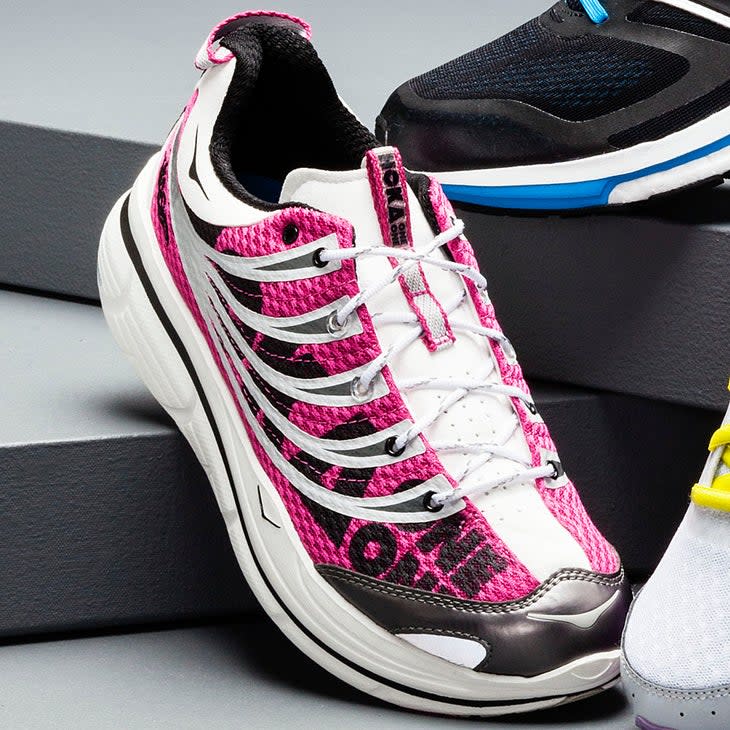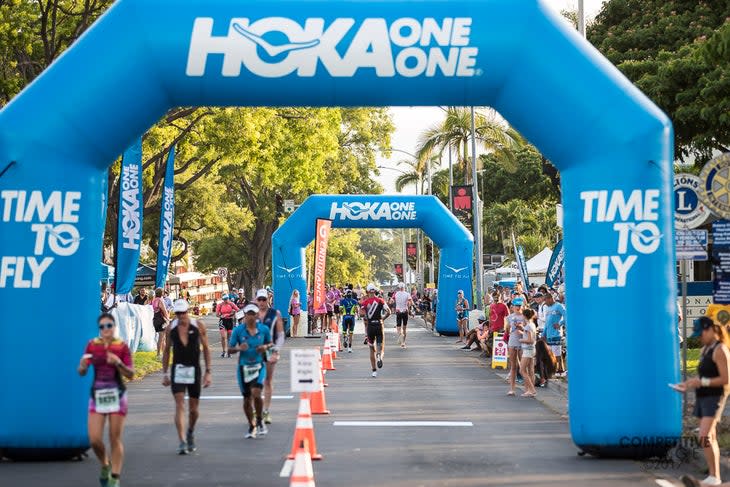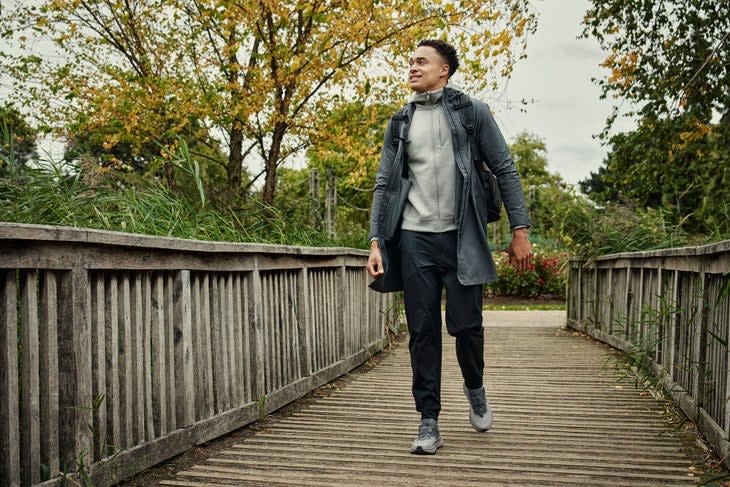The Pretty People Are Coming for Your Hokas
This article originally appeared on Outside
It's not often that triathletes, social media influencers, sneakerheads, and service workers have a similar fashion interest. But one brand born in the French Alps that fuses performance and a distinct aesthetic point of view seems to have united people all over the world--to the extent that it's quickly pacing towards $1.5 billion in sales this year alone.
Since its launch in 2009, Hoka has soared from the seed of an idea--a shoe for easier, more buoyant downhill running--to what's largely considered the sneaker market's fastest-growing brand. But was it word of mouth, clever marketing, an effective celebrity seeding strategy, or just a happy (and very commercially successful) accident?
The anti-minimalist shoe

Let's take a step back to figure that out. Taking their cue from the Maori phrase "flying over the earth," former Salomon employees Nicolas Mermoud and Jean-Luc Diard founded Hoka One One (pronounced on-ay on-ay, as opposed to the number) to design a shoe with a cushioned, outsize sole that would mimic the feeling of bouncing on air. Compared to traditional running shoes, their models had thick, added cushion and a wider sole, used lighter materials, and featured a rocker shape in the midsole under the toe. This, they posited, would solve a universal problem for all runners: maintaining momentum.
"Jean-Luc is a visionary," says Adam Chase, a runner and triathlete who has reviewed 1,000s of running shoes, says. "The first iteration was way ahead of its time. It was like a marshmallow shoe, and at first everyone laughed. But the founders really saw where the ball was going to go."
Chase contextualizes that back around 2009 and 2010, the barefoot running movement was all the rage, largely led by Christopher McDougall's best-selling book Born To Run, which encouraged runners to feel the ground beneath them.
"Most of us don't live in the mountains, we live on concrete," Chase counteracts. "There was bound to be a pendulum swing [away from the minimalist 'five finger shoes'] and Hoka really led this charge back to the maximization of running."
But Hoka's capture of the market wasn't simply an overnight success. Erika Gabrielli, Senior Director of Global Integrated Marketing at the company, recalls that in August 2009, the founders were at UTMB in Chamonix, using the race as the first litmus test as to whether the shoe would be a hit.
"It wasn't so much of a runaway success," Gabrielli says. "But there was an early fan base, [our] evangelists, thanks to the unique and distinct design. It was a slow burn, but word of mouth in the trail running community and adoption by elite athletes [helped.] Some ultra trail runner friends of the brand wore the shoe and placed first and second in races in 2009, and from there it really started to grow."
The first Hoka shoe hit stores in 2010. Around this time, the founders themselves were the ones actually on the ground, trying to land accounts at specialty running stores in the U.S. At a trade show that year, the Boulder Running Company bit and placed an order of 770 sneakers. "It was such an influential account," Gabrielli says. "In terms of exposure and scaling. It evoked a feeling in our founders and they started experimenting about adding other types of shoes."
The triathlete effect

From those 770 pairs, the super-cushy shoes became millions. Within just a few years, it was estimated between 40 to 60 percent of ultrarunners were wearing Hokas. Triathletes (and their well-established reputation as early adopters of new tech) soon followed. By 2017, Hoka was the top shoe at the annual Kona Shoe Count, delivering a knockout to traditional favorites like Asics and Saucony.
"It's a pragmatic shoe for a triathlon," says Chase. "Runners need a good recovery shoe, and Hoka epitomizes it. It's extremely cushioned, but it's not just softness and lightness, there's also rebound. In many ways, it's the perfect shoe for getting on your feet to run after biking 112 miles, because you're kind of shot. You need to get your legs moving, and avoid the 'Ironman shuffle.'"
Hoka devotees became almost evangelical about the shoes, recommending a pair to everyone from runners who quit the sport due to knee problems to workers who spend all day on their feet.
"Postal workers on their feet yearn for something like this," Chase adds. "Or chefs on rubber mats. It's a counteraction to having to stand all day on a hard surface. They really are made for recovery."
Hoka leaned into that comfort-for-all identity. Instead of doubling down on its identity as a running shoe, it expanded its marketing to brand itself as a shoe for all. During the COVID-19 pandemic, for example, the brand marketed to healthcare professionals, noting the incredible physical demands of their jobs.
Nurses travel over 3 miles through the course of each 12 hour shift. That's twice the step count of an average adult, and more than a marathon every month. Thank you for being there for us, now and always. https://t.co/LM3jzitF5U
— HOKA (@hoka) May 12, 2020
Hoka still is, of course, a running shoe company. But Jean-Luc Diard's innate innovation has created something much bigger than running, says Chase.
"The French way of thinking is very different and unorthodox by American corporate standards. He's able to think differently, and way ahead, which has allowed them to be ingenious. I mean, you can see his work now at Deckers X Lab. The company is cooking up some really impressive recovery shoes which look like extreme, even more pronounced versions of Hokas."
Running, yes, but make it fashion

Speaking of extreme soles, it's not too surprising to track the popularity of Hokas amongst a fashion-conscious crowd, as the 2010s were undoubtedly the era of the "dad shoe." From the surprising proliferation of Crocs and Birkenstocks to luxury brands like Chanel, Gucci, and Prada selling $1,000+ tourist-style sandals, and Balenciaga and Yeezy's chokehold on the sneaker market, all eyes were on clunky, chunky styles. Hoka entered the lifestyle market in 2021, adding colorful suede fashion versions of its popular Clifton and Bondi styles.
One foolproof way for an emerging brand to gain mass attention is to collaborate with someone established in another space. Via partnerships with the likes of Moncler, Free People Movement, Engineered Garments, and J.L-A.L_, Hoka was able to "connect to culture" and "extend its reach," per Gabrielli.
To get a sense of what that attention and reach looks like, consider that the #Hoka has 377.8 million views on TikTok alone, while #Hoka and #HokaOneOne has been tagged in almost 2.5 million grid posts on Instagram.
"I think the brand has always taken a strategic approach in terms of collaborations," Gabrielli says. "We're still relatively small, and that's by design, but we know there's opportunity in the fashion space. We see where we can find a partnership that helps us do things right that we can't do on our own. We want to see where we can connect and be creative, defy convention, and do something that hasn't been done before."
She adds, "We're still performance-based; that's where the special mashup is. [Fashion-focused partners] can help to take that performance and position it in new and different ways without sacrificing innovation. One thing we've always found to be a universal truth is that everyone is looking for newness, and looking for comfort."
Another thing people are always looking to? Celebrity. Among the influential figures who've been spotted in Hoka are Hollywood heavyweights (Cameron Diaz, Reese Witherspoon, Gwyneth Paltrow, Adam Sandler), supermodels (Emily Ratajkowski, Bella Hadid, Winnie Harlow), and pop stars (Britney Spears).
"It's a bit of both," Gabrielli offers when asked if Hoka actively seeds its product amongst celebrities. "We have ambassadors, athletes, and influencers, but we also see a lot of organic adoption--whether that's amongst the average joe or celebrities. [An exciting moment] recently was Harry Styles, who we saw working out in Hoka."
Gabrielli also credits community events, social media, and the brand's company values (philanthropy, sustainability) for furthering the message and appeal. But when it comes down to the overall rapid success, it does appear to be organic word of mouth that has propelled these big-soled shoes to new heights.
Madeline Yanni is a New York City-based fashion influencer who has been wearing Hoka for about a year. "I first heard about the brand from my photographer, Madison White, who also doubles as my running buddy. She was wearing a pair on one of our runs together and I thought they looked really cool. She told me they were insanely comfortable and I was sold."
Yanni, who calls herself a longtime intermediate and leisurely runner, is a fan of the cushion and support. "I have high arches so I would have to purchase inserts for my running shoes to get the support I needed, but now I don't have to worry about that."
As for the style, which she says is important to her as someone who eats, sleeps, and breathes fashion, she says she loves how "different" and "unique and fun" the design is from other offerings on the market: "The platform looks like a wave and the colorways they offer feel very tropical."
"Working in the fashion industry for almost ten years now, I am very particular about what shoes I wear on any given day. Running shoes are no exception--they need to be aesthetically pleasing too," she laughs. "My favorite thing about wearing Hoka is that style and comfort don't have to be mutually exclusive."
RELATED: How to Pick the Right Running Shoe Today
For exclusive access to all of our fitness, gear, adventure, and travel stories, plus discounts on trips, events, and gear, sign up for Outside+ today.

